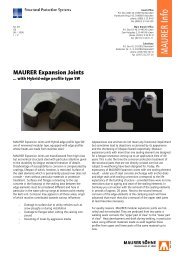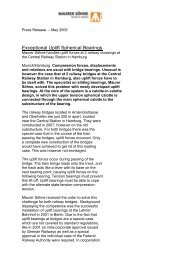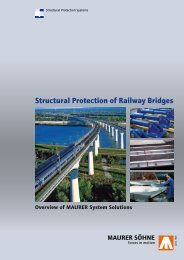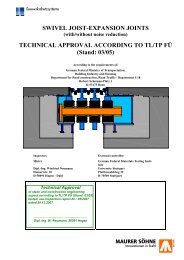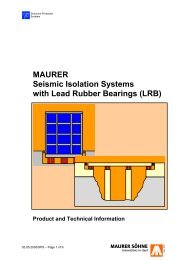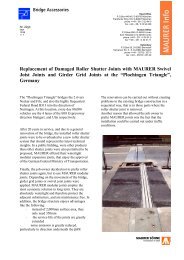Noise Reduction of Modular Expansion Joints by means of rhombic ...
Noise Reduction of Modular Expansion Joints by means of rhombic ...
Noise Reduction of Modular Expansion Joints by means of rhombic ...
You also want an ePaper? Increase the reach of your titles
YUMPU automatically turns print PDFs into web optimized ePapers that Google loves.
No. 24 (gb)HeadquartersP.O.Box 440145, D-80750 MünchenFrankfurter Ring 193, D-80807 MünchenTelephone (++49-89) 3 23 94-0Telefax (++49-89) 3 23 94-306EW/VBABranch Office01/2001 P.O.Box 300454, D-44234 Dortmund1 / 10 Westfalendamm 87, D-44141 DortmundTelephone (++49-231) 4 34 01-0Telefax (++49-231) 4 34 01-11SubsidiaryP.O.Box 55, D-02992 BernsdorfKamenzer Str. 4 - 6, D-02994 BernsdorfTelefon (++49-35723) 237-0Telefax (++49-35723) 237-20<strong>Noise</strong> <strong>Reduction</strong> <strong>of</strong> <strong>Modular</strong> <strong>Expansion</strong> <strong>Joints</strong><strong>by</strong> <strong>means</strong> <strong>of</strong> <strong>rhombic</strong> steel platesObjective <strong>of</strong> theinvestigations asdescribed belowwas to minimizenoise emissions<strong>of</strong> modular expansionjointsthat – at least inGermany – areexclusively usedin bridges. Wewill show that inattaching overhanging<strong>rhombic</strong>steel plates tothe lamellas <strong>of</strong>the joint, a functionaland effectivesolution wasdeveloped thatconsiderablyreduces noiseemissions.... Can also be used as snowplough protection!
No. 24 (gb)EW / VBA01/20012 / 10<strong>Noise</strong> reduction <strong>of</strong> <strong>Modular</strong> <strong>Expansion</strong> <strong>Joints</strong><strong>by</strong> <strong>means</strong> <strong>of</strong> <strong>rhombic</strong> steel plates1. GeneralThe embarrassment <strong>of</strong> the public due to trafficnoise is an ever-increasing problem for designers<strong>of</strong> roads and bridges. In case <strong>of</strong>bridges, noise emission is not only directed toabove the carriageway, but also in directionbelow, and is in addition also intensified due tooscillations <strong>of</strong> the bridge construction. Particularlycumbersome are noise emissions due toimpact, like they usually occur at a non-smoothcarriageway and at expansion joints.Sound level difference in dB betweenexpansion joint and carriageway10987654321MAURER has realized the importance <strong>of</strong> noisereduction <strong>of</strong> expansion joints more than 10years ago. Since 1991, we investigate in noisereduction <strong>of</strong> expansion joints <strong>by</strong> <strong>means</strong> <strong>of</strong> testvehicles passing expansion joints <strong>of</strong> differentdesign types.0roller shutter± 225 mmmodular expansionjoint± 200 mmFig. 1: Vehicle, 80 km/hrubber mat± 50 mmfinger joint± 75 mmmodular exp. Jointwith <strong>rhombic</strong> plates± 200 mmIn using the median level <strong>of</strong> the sound pressure,troubling effects <strong>of</strong> the impact like noiseemissions <strong>of</strong> passing traffic are not correctlycovered. So far it does not yet exist a marginon top <strong>of</strong> the median level according to whichthe increased troubling effect can be properlyevaluated. This is why in order to evaluate thetroubling effect, the difference between maximumlevel and minimum level was applied.On order to evaluate the level difference betweencarriageway and expansion joint, anadditional noise-measuring device was placed25m in front <strong>of</strong> the expansion joint. Both noisemeasuringdevices were located 1.5m aboveand 1m beside the edge <strong>of</strong> the carriageway.Fig.1 shows the differences <strong>of</strong> the noise levels<strong>of</strong> each 3 measurements for 4 different designtypes <strong>of</strong> expansion joints. In comparison to thiswe then display the modular expansion jointswith deposited <strong>rhombic</strong> steel plates on top.Test vehicle was a medium-sized vehicle withradial tires, which employed bigger differencesin noise level than in tests with a truck as testvehicle. The displayed values were taken at avelocity <strong>of</strong> 80 km/h. Measurements taken atdifferent velocities showed that the differencesin noise level were almost constant and independent<strong>of</strong> velocity.2. <strong>Noise</strong> <strong>Reduction</strong> <strong>of</strong> <strong>Modular</strong> <strong>Expansion</strong><strong>Joints</strong>Objective <strong>of</strong> the tests described below was toreduce noise emissions <strong>of</strong> modular expansionjoints in evaluating various modifications <strong>of</strong> andsupplements to a modular joint. It was an idealprecondition that the in situ test could be carriedout at the abutment <strong>of</strong> one and the samebridge.
No. 24 (gb)EW / VBA01/20013 / 10<strong>Noise</strong> reduction <strong>of</strong> <strong>Modular</strong> <strong>Expansion</strong> <strong>Joints</strong><strong>by</strong> <strong>means</strong> <strong>of</strong> <strong>rhombic</strong> steel platesLikewise, in order to compare the differentmeasurements, always the same test vehiclewas used.b) Elastic coating <strong>of</strong> the surface <strong>of</strong> the centerbeams in addition to the gap fillings as describedin a)Basis for the selection <strong>of</strong> the different noisereducing applications was the realization that,as far as modular expansion joints are concerned,the embarrassing noise is mainly created<strong>by</strong> the wheels hitting the edges <strong>of</strong> thesteel beams that are arranged rectangular tothe direction <strong>of</strong> the traffic.From the many experiments that were carriedout, we would like to cite the following ones:a) Joint gaps filled to the top <strong>of</strong> the carriagewaywith cut-<strong>of</strong>f rubber and joint sealantFig. 3In addition to the method as described in a),an elastic coating was applied over thewidth <strong>of</strong> the joint. Like in a), also in this caseafter a few weeks cracks were observed inthe coating, which lead to detachmentsfrom the center beams shortly thereafter.c) Non-overhanging, <strong>rhombic</strong> shaped plateson top <strong>of</strong> the lamella beams <strong>of</strong> the expansionjointFig. 2The noise reducing effect stems mainlyfrom the fact that the wheels are preventedto penetrate as deep into the gap as before.However we did not find any cut-<strong>of</strong>f rubberand no joint sealant, which could sustainthe strains and deformations without damageover a certain minimum time period.Minor modifications <strong>of</strong> the gap width andthe strains due to the wheels lead to cracksand detachments from the joint after only afew weeks.Fig. 4
No. 24 (gb)EW / VBA01/20014 / 10<strong>Noise</strong> reduction <strong>of</strong> <strong>Modular</strong> <strong>Expansion</strong> <strong>Joints</strong><strong>by</strong> <strong>means</strong> <strong>of</strong> <strong>rhombic</strong> steel platesObjective <strong>of</strong> this arrangement was that thewheels should be prevented to hit a continuoussteel edge; instead they should hitthe rounded tips <strong>of</strong> the rhombus plates,which should considerably mitigate the impact.The noise reduction that was achievedin this test might be improved even furtherin applying thicker rhombus plates thanthose applied in this test.e) Overhanging <strong>rhombic</strong> steel plates on top<strong>of</strong> the lamella beams <strong>of</strong> the expansion jointd) Sinusoidal shaped plates on top <strong>of</strong> the centerbeams <strong>of</strong> the expansion jointsFig. 5Like a finger joint, the tips <strong>of</strong> the plates protrudeover the gaps, with adjacent platesforming a toothing. The cantilever plate tipsare not supported <strong>by</strong> the opposite edge <strong>of</strong>the beams. This design is an enhancement<strong>of</strong> the type described in c), because thesinking <strong>of</strong> the wheels into the gaps betweenthe center beams is prevented.Fig. 6The <strong>rhombic</strong> steel plates are fixed <strong>by</strong> cavitywelding on the underneath arranged lamellabeams. In contrast to version c), the corners <strong>of</strong>the <strong>rhombic</strong> steel plates go beyond the edges<strong>of</strong> the beams without having contact to theneighbouring beams (similar to version d)).The rhombi cover the adjacent gaps and form,as in the case <strong>of</strong> the sinusoidal shaped plates,a toothing with adjacent steel rhombi. Whilethe noise reduction has the same value comparedto version d), the fatigue resistance isconsiderably higher and the manufacturing ismore efficient.The test results are displayed in Fig.6. Also inthis case two noise measuring devices wereinstalled, one directly at the expansion jointand the other one in 25m distance. Both deviceswere located 1.5m above and 1m besidethe edge <strong>of</strong> the carriageway.
No. 24 (gb)EW / VBA01/20015 / 10<strong>Noise</strong> reduction <strong>of</strong> <strong>Modular</strong> <strong>Expansion</strong> <strong>Joints</strong><strong>by</strong> <strong>means</strong> <strong>of</strong> <strong>rhombic</strong> steel plates4,543,532,521,510,50standard expansionjoint and carriagewaygap filled with rubberrhombus platesSound level difference in dB betweenexpansion joint and carriagewaycoating<strong>rhombic</strong> platesFig. 6Under the bridge – at the opening betweenbridge deck and abutment – the noise reduction<strong>of</strong> this method as compared to the „standardversion“ <strong>of</strong> an expansion joint turned outto be 5dB for the test truck and 9.5 dB for thetest vehicle.3. The new low-noise watertightmodular expansion joint with<strong>rhombic</strong> steel platesThe comprehensive experiments and soundmeasurements lead to the development <strong>of</strong> thenew watertight expansion joint employing“wave shaped” or “zigzag” gap openings at thesurface <strong>of</strong> the carriageway.Fig. 7Compared to conventional modular expansionjoints, above and below the carriageway considerablylower sound pressure levels can beobserved, to be:Above the carriageway Truck at a speed <strong>of</strong> 80 km/h to be 4 dB (A)lower Vehicle at a speed <strong>of</strong> 120 km/h at around 6dB (A) lower
No. 24 (gb)EW / VBA01/20016 / 10<strong>Noise</strong> reduction <strong>of</strong> <strong>Modular</strong> <strong>Expansion</strong> <strong>Joints</strong><strong>by</strong> <strong>means</strong> <strong>of</strong> <strong>rhombic</strong> steel platesandunderneath the carriageway Truck at a speed <strong>of</strong> 80 km/h at around. 5dB (A) lower and Vehicle at a speed <strong>of</strong> 120 km/h at around 9dB (A) lowerThe noise emissions <strong>of</strong> this new type <strong>of</strong> modularexpansion joints are comparable to those <strong>of</strong>conventional finger joints that among expertsare widely considered to emit least noise <strong>of</strong> alltypes <strong>of</strong> expansion joints made <strong>of</strong> steel.Compared to conventional finger joints however,the advantages <strong>of</strong> modern watertightexpansion joints still apply.a) Vertical Deflections u z <strong>of</strong> the 2 edges <strong>of</strong> thejoint result in a slightly inclined plane thatdoes not lead in a stepwise vertical <strong>of</strong>fset.Uq1Fig. 11, Fig. 12Uq ges. = x . Uq1Uq ges. = Uq1Fig. 8c) Bigger movements <strong>of</strong> the joint in maindirection <strong>of</strong> the carriageway result in manysmall individual gaps running perpendicularto the direction <strong>of</strong> traffic (Fig.12). Conventionalfinger joints allow big openings, i.e.slots. These long slots in the carriagewayare particularly hazardous for bicycle drivers(see Fig.13).Fig. 9b) Unplanned lateral displacements <strong>of</strong> theedges <strong>of</strong> a joint u q can be accommodatedto a considerable degree and do not, as it isthe case in finger joints, after a few mm <strong>of</strong>displacement lead to a contact <strong>of</strong> the fingers,i.e. flanges <strong>of</strong> the teeth (Fig.11)
No. 24 (gb)EW / VBA01/20017 / 10<strong>Noise</strong> reduction <strong>of</strong> <strong>Modular</strong> <strong>Expansion</strong> <strong>Joints</strong><strong>by</strong> <strong>means</strong> <strong>of</strong> <strong>rhombic</strong> steel plates Sliding and control elements as well as theelastomeric strip seal can, in case <strong>of</strong> need,be replaced from above. For this purpose,the horizontally resiliently supported sinusoidalplates can be shifted to such an extentthat a sufficient large gap will be createdfor replacement purposes.widened gapopeningsFig. 13d) Water and dirt will be collected <strong>by</strong> the elastomericstrip seals in the individual gaps,and are therefore prevented to protrude intothe area between superstructure and abutment.e) Center beams that are horizontally supportedin a resilient manner can yield sidewaysto the neighboring gaps. This way,eventually squeezed particles cannot damagethe expansion joint.Further important requests were complied: The <strong>rhombic</strong> steel plates are not screwed tothe steel beams underneath. This way wecontinue to stick to our philosophy thatstructural members that are exposed to dynamicloads, should whenever possible, notbe fixed <strong>by</strong> screws or bolts to avoid danger<strong>of</strong> loosening connections.Fig. 14 The <strong>rhombic</strong> steel plates are patented intheir shape as well as in their arrangement.The length <strong>of</strong> the cantilever tip <strong>of</strong> the steelplate is limited to half <strong>of</strong> the maximum permissiblegap width. This way, a relativelythin plate thickness is possible, with theplate not being supported <strong>by</strong> oppositeedges <strong>of</strong> steel beams. These new “low noise joints” can cater tothe same movement <strong>of</strong> a bridge as conventionalmodular joints (i.e. movement <strong>of</strong> thejoint is not impeded or restricted <strong>by</strong> thesesinusoidal steel plates).It is possible to retr<strong>of</strong>it the bridges withthese steel plates, i.e. the steel plates canbe welded to existing expansion joints.
No. 24 (gb)EW / VBA01/20018 / 10<strong>Noise</strong> reduction <strong>of</strong> <strong>Modular</strong> <strong>Expansion</strong> <strong>Joints</strong><strong>by</strong> <strong>means</strong> <strong>of</strong> <strong>rhombic</strong> steel plates4. Winter ServiceSnowploughs can pass modular expansionjoints when the axis <strong>of</strong> the joint is perpendicularto the direction <strong>of</strong> traffic. However, in casethe angle <strong>of</strong> the axis <strong>of</strong> the joint corresponds tothe skew arrangement <strong>of</strong> the shield <strong>of</strong> thesnowplough (usually this angle is between 55°and 60°), the snow shield can fall into the gapand cause damages to the joint. The solutionwith wave shaped gaps as described here isgenerally suited to prevent such accidents.Rhombic steel plates as snowplough protectionshould only be employed in such cases wherethe above-mentioned angles correspond. Wewould like to add that skew arrangement <strong>of</strong>gaps lead to a considerable reduction <strong>of</strong> noise.Proposal for specification:<strong>Noise</strong> reducing design at the surface <strong>of</strong> watertightmodular expansion joints <strong>by</strong> <strong>means</strong> <strong>of</strong>wave shaped gaps (System MAURER or similar)The <strong>rhombic</strong> steel plates must not be screwedto the supporting lamellas (center beams).Cantilever parts <strong>of</strong> the plate must not touchparts below (i.e. no 2 nd support).The thickness <strong>of</strong> the cantilevering plates shallbe designed according to structural and constructiverequirements, shall however not beless than 15 mm. Strip seals as well as slidingelements and control elements must be able tobe replaced from above.The noise reducing design must be carried outover the total width <strong>of</strong> the carriageway. Theasphalt must connect in level to the upperedge <strong>of</strong> the sinusoidal plates.
No. 24 (gb)EW / VBA01/20019 / 10<strong>Noise</strong> reduction <strong>of</strong> <strong>Modular</strong> <strong>Expansion</strong> <strong>Joints</strong><strong>by</strong> <strong>means</strong> <strong>of</strong> <strong>rhombic</strong> steel platesREFERENCESReference projects Owner MAUREROrder no.TypeCommentUrsteinbrücke Niederalm Amt der Salzburger Landesregierung 57 0224 DF100 under trafficSalzachbrücke Paß Lueg Amt der Salzburger Landesregierung 57 0232 DF60 / 24-I under trafficK5, Innbrücke KufsteinAmt der Tiroler Landesregierung 57 0246 DF180 under trafficInntal-AutobahnA10, Raschl- und Almbrücke Amt der Salzburger Landesregierung 57 0257 A-D80 W/24 under trafficAmraser Brücke, A12 – B2 Amt der Tiroler Landesregierung 57 9011 DF60 B / 16-I under trafficBW 17/3 + 17/4, Autobahnring ABD München 59 0112 D80 Ü under trafficMünchen. WL Salzburg - RFB NBW 18, B31 zwischenSBA Freiburg 59 0141 D80 Ü under trafficFreiburg und KirchzartenBW 3, Fischenzstraße Konstanz SBA Konstanz 59 0409 D80 Ü under trafficBW 322-2, Talbrücke Trockau, A9 ABA Nürnberg 50 0613 D560 installedEtschbrücken in MarlingAutostrada ME-BOAutonome Provinz Bozen 56 0777 DF80DSF240under trafficBrücke Villnöss Autonome Provinz Bozen 56 0808 D80 F / D240 F under trafficBW 7, Brücke über die Wehra SBA Bad Säckingen 50 0839 D240 under trafficBW 30 und BW 31 der A10 ABA Brandenburg 54 0863 D240 in productionBW 5, Talbrücke Zschonergrund ABA Sachsen 50 0878 D240 under trafficBW 40a, BW 41,Berliner Ring bei LudwigsfeldeDEGES, Land Brandenburg 54 0880 D80 B-ÜD240under trafficMoselbrücke Wehlen SVA Trier 50 0960 DS240 under trafficBrücke über den Mühlengraben TBA Cottbus 54 0961 D80 B-Ü under trafficBW 235, Innbrücke Suben ABD Regensburg 50 0965 D400 under trafficBarmbeker-Ring-Brücke, Hamburg Stadt Hamburg, TBA 55 7590 D240 under trafficMoselbrücke Mehring SVA Trier 56 1334 DS400 / D80 Ü under trafficBW 15, Talbrücke Weißeritz ABA Sachsen (Dresden) 56 1344 D400 Übe 1 planning stageAutobahndreieck Neukölln,5 BrückenUF der OEG / L 637Neubau 1. BA (Ost)Donnergraben- undEckgrabenbrückeSenat Berlin 56 1345 D160 / D240 in productionD320ABA Karlsruhe 56 1455 D80 Ü GO under trafficAmt der Salzburger Landesregierung 57 9020 D300 GO/14D140 GO/14D200 GO/14in productionBW 3, Talbrücke Münchingen SBA Besigheim 50 1504 D320 GB in productionA23 Udine – Tarvisio,5 BauwerkeAutostrada Udine-Tarvisio S.p.A. 56 1505 DS560 GOund fuse boxunder trafficBrücke ü.d. DB bei Ringsheim SBA Offenburg 56 1539 D160 GO under trafficBW 33, Müglitztalbrücke Freistaat Sachsen 54 1713 D400 B-GO planning stageBulacher Hochbrücke, Karlsruhe TBA Karlsruhe 56 1531 D160 GOunder trafficD80 Ü GOSchanzlbrücke Passau SBA Passau 56 1534 D160 GO under trafficBW K10, OU Wallau-Biedenkopf, ASV Marburg 50 0871 D240 GO under traffic
No. 24 (gb)EW / VBA01/200110 / 10<strong>Noise</strong> reduction <strong>of</strong> <strong>Modular</strong> <strong>Expansion</strong> <strong>Joints</strong><strong>by</strong> <strong>means</strong> <strong>of</strong> <strong>rhombic</strong> steel platesREFERENCES (continued)Reference projects Owner MAUREROrder no.TypeCommentA 12, Westabfahrt Innsbruck Amt der Tiroler Landesregierung 57 0265 D120 GO/9 under trafficK 56/2, Pfettrachbrücke ABD Südbayern / DS Regensburg 50 1592 D240 GO under trafficHaller Innbrücke, B 171 A Amt der Tiroler Landesregierung 57 0267 D120 GO/9 in productionBW306a, Mainbrücke Dettelbach ABD Nordbayern / DS Nürnberg 50 1615 D560 GBD320 GB1. BA: installed2. BA: planning stageBW 15-1, Wernbrücke Geldersheim SBA Schweinfurt 50 1619 D240 GO in productionA 71, Talbrücke b. Maibach, BW 6-2 SBA Schweinfurt 50 1668 D480 GO planning stageB 260, Umgehung Fachbach –Bad Ems, Lahnbrücke 1SPA Vallendar 50 1450 D480 GOD320 GOinstalledUferbrücke Neckarelz SBA Heidelberg 50 1720 D320 GO installedMoselbrücke Traben-Trarbach SVA Trier 50 1728 D240 GO planning stageNibelungenbrücke Regensburg, TBA Regensburg 50 1729 D80 Ü/180 GO in productionBW 2, 3 und 4Talbrücke Pilsach ABD Nordbayern / DS Nürnberg 50 1831 DS480 GO planning stageSchanzlbrücke „Süd“ SBA Passau 50 1816 D240 GO planning stageNaabbrücke Schwarzenfeld SBA Sulzbach-Rosenberg 56 1854 D160 GO planning stage



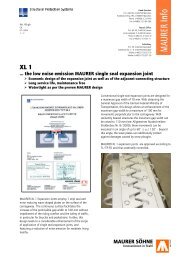
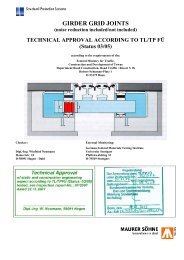
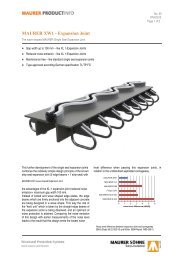
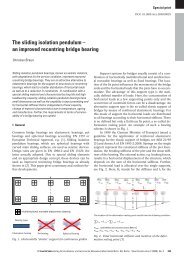
![[Brochure] MAURER Tuned Mass and Viscous Dampers](https://img.yumpu.com/46663805/1/184x260/brochure-maurer-tuned-mass-and-viscous-dampers.jpg?quality=85)
![[Broşürler] MAURER Tek Açıklıklı Genles¸me Derzleri](https://img.yumpu.com/41620362/1/184x260/brosurler-maurer-tek-acklkl-genlesme-derzleri.jpg?quality=85)
